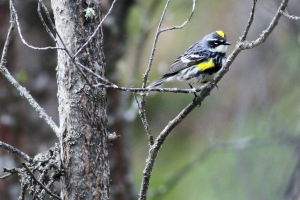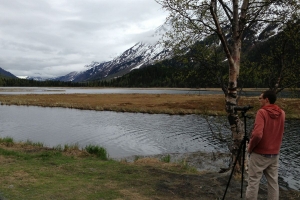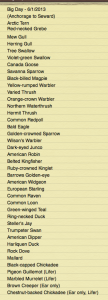Click to listen to the extended audio version:
Today we’re going birding, and the first thing you should know about it, is that it starts really early. It’s 5:40am, on Saturday. Way early than I usually wake up. I’m going to try and slip out of here without waking the wife and the dog. Let’s go do some birding.
Our guide today is Zac Clark. He’s doing what birders call a “Big Day.” The guidelines are simple: identify as many birds as you can within a 24 hour period.
Birds can be added to a Big Day list two different ways: seeing them, or hearing them. Although Clark has been a fan of birding for a while now, this is only his second Big Day. That’s because his first one, which he was doing on the Potter’s Marsh boardwalk, ended in disaster.
“The heaviest part of my spotting scope swung out over the edge and plummeted 20 feet into the dirty, filthy water. So at that point my Big Day came to end, and it became a rescue operation for my spotting scope,” says Clark.

It’s been almost a year since that tragedy, and Clark is excited to give it another go. “If my spotting scope finishes the Big Day dry, then it will be a success,” says Clark.
Today we’re driving from Anchorage to Seward, but there’s plenty of stops along the way to get our list started. Our first stop is filled with seagulls.
“You have the Mew Gull here, they have sort of a greenish tint to their legs, and they have the smaller bill,” says Clark.
There are actually five different birds here. That’s one thing you find out early about birding; there are so many you don’t notice until you actually stand still and listen.
By the time we arrive in Seward our list is getting pretty long: right around 25. I ask Clark if there’s one bird he really wants to find here today. He’s resistant at first, but I do get it out of him. He’s afraid we’ll jinx it.
“I want to find the chestnut-backed chickadee,” Clark admits.
That search will have wait though. Chestnut-backed chickadees are mostly found in wooded areas, and there are a lot of sea birds to find in Seward, including one that Clark has never seen before: the Black Guillemot.
Clark fishes his phone out of his pocket and opens up a birding app to see if the bird matches.

“The white on the wings, the black head; I think we have a successful identification. That would be a new bird to add to my life list,” says Clark. A life list as you might guess is the ultimate list for birders, and documents every species they’ve seen. Clark says this matches his personality quite nicely.
“I have this obsessive need to collect things. So when you’re going out and you’re spending a few hours you can collect the birds that you see, and not have to bring home anything physical. It’s the search that’s half the fun,” says Clark.
And, our search is nearing an end, but we have one last stop: the Mount Marathon trail. We’re hoping to add a few more birds to our list here, but the trees are thick with leaves this time of year, and it’s hard to see anything.
“Not only do you want to train your eyes; you have to work on your ears as well,” says Clark. That part is easier said than done, but Clark is able to identify a few birds just by ear. As we trudge further up the hill, he even picks out the song of a ruby-crowned kinglet.

As we go on we realize it’s getting late. And the birds have stopped singing. We decide we’ll hike for 15 more minutes and then call it a day. And not long after, we hear a bird that stops Clark in his tracks.
“It sounds like it’s talking to somebody up here. Whatever it is its way in the top of those spruce trees,” says Clark. We can’t see it, but after listening for a few minutes we’re almost certain that it’s the chestnut-backed chickadee we had been hoping to find.
“That’s what it has to be. It’s like a chickadee on speed. You hear that?” says Clark. We want to be certain, so we consult the iphone one last time.
“Totally, that was it, that’s our bird,” says Clark. And that might just be the perfect end to a Big Day, but first I have to ask Clark the final total.
“36? Not too bad. I’d love to be over 40,” he says.
And, we’re able to find four more birds on our way back to Anchorage. Our final bird is so common that we’re shocked we haven’t see one all day long. A pigeon. With 40 birds under our belt, and a very dry spotting scope, it’s time our Big Day came to an end.
Dave Waldron began his radio career in 2000 as a volunteer DJ at UAA’s radio station KRUA 88.1, where he hosted a weekend music show. In 2004 he was hired as the station’s music director, and held the position until his graduation in 2007. He was hired by Alaska Public Media in 2008 and since then has worked as an audio engineer, editor, and producer. He currently runs his own small business AK Audio Pro, and is a host of Alaska Public Media’s Hometown, Alaska.





